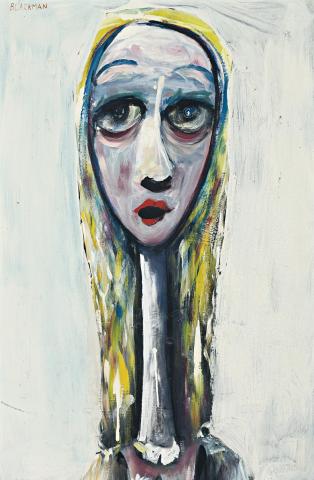ALICE, c.1957
CHARLES BLACKMAN
tempera and oil on composition board
91.0 x 60.0 cm
signed upper left: BLACKMAN
Private collection, Melbourne
Tolarno Galleries, Melbourne
DC Art, Sydney
Private collection, Sydney, acquired from the above in 1990
Tolarno Galleries, Melbourne, 1980
Charles Blackman's Alice in Wonderland series of paintings preceding this work, are among the best Australian art has to offer, rivaling even Sidney Nolan's iconic Ned Kelly.
As has often been noted, Blackman does not provide a mere body of illustrations to Lewis Carroll's nineteenth-century masterpieces, Alice's Adventures in Wonderland and its sequel Through the Looking-Glass.
Rather, they are an inspired collaboration between author and painter. Nonsense literature, with its mixture of sense and nonsense, sporting with logic in a delicious mixture of word play and fantasy, finds highly individual visual presence in Blackman's paintings. Moreover, as Judith Wright observed, 'His painting is not of the world of things, but of the world of our experience of them, in which they are changed from things to meanings.'1 Parallels, of course, exist, as in our Alice c1957, who is not unlike John Tenniel's original illustration to the moment of curiosity that begins chapter two of the Adventures.
'Curiouser and curiouser!' cried Alice (she was so much surprised, that for a moment she quite forgot how to speak good English); 'now I'm opening out like the largest telescope that ever was! Good-bye, feet!'2
Tenniel's and Blackman's Alice both have similar extended necks, oval faces, and long, childlike hair. Differences lie in expression. Tenniel's Alice is wide-eyed, mixing surprise with curiosity. Blackman's shares the open mouth and eyes, but the latter reveal concern. In Blackman's world, Alice is his wife Barbara, the artist himself a maniacal White Rabbit. It was Melbourne in 1956. Barbara was going blind; Blackman heard her listening to Alice's adventures from the Talking Book Library for the Blind. Fact and fiction provided the mix that set his creative imagination alight. The solitary Alice come Barbara portrays a poignant moment - emphasis on the eyes of Barbara's growing loss of sight, of inner loneliness in the isolation of the figure, and a look knowing, defensive, yet vulnerable. Duality is touched upon in Judith Wright's reflection, Alice'is the perfect companion for a painter, and Blackman was wise enough to know it from the moment she appeared.'3 Moreover, an extraordinary empathy with children, is blended with the biographical, intuitively expressed in a child-like freshness of vision and wonderment, the real world and of the imagination as one. There is also a highly playful anthropomorphism as teapots pour on their own and rabbits play complicated games, seen in A Curious Feeling 1956 (private collection, Melbourne), and The Game of Chess 1956 (private collection). In this paradox of images, childlike and sophisticated, as if created by children for children to be enjoyed by adults, Blackman follows in Lewis Carroll's footsteps, passing into legend in his own lifetime.
1. Wright, J., 'Foreword', Charles Blackman (catalogue), Johnstone Gallery, Brisbane, June 1957
2. Carroll, L., Alice's Adventures in Wonderland, The Folio Society, London, 1961, p. 11
3. Wright, J. (catalogue foreword), Alice in Wonderland by Charles Blackman, Johnstone Gallery, Brisbane, September 1966
DAVID THOMAS
